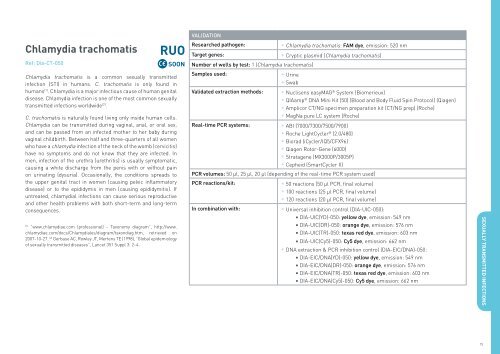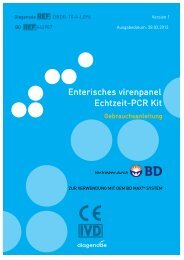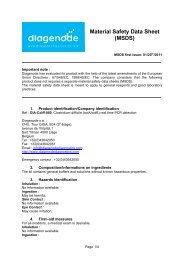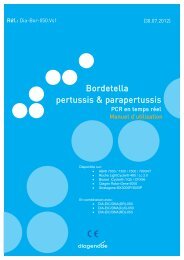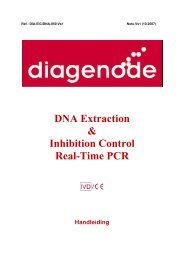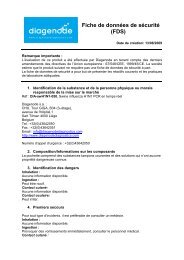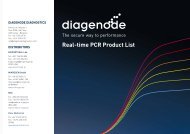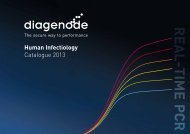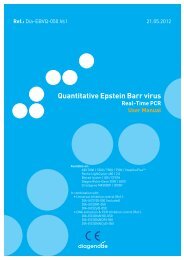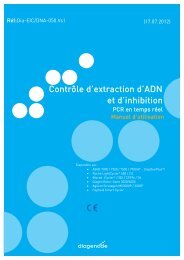Human Infectiology MDx | Catalogue 2011 - Diagenode Diagnostics
Human Infectiology MDx | Catalogue 2011 - Diagenode Diagnostics
Human Infectiology MDx | Catalogue 2011 - Diagenode Diagnostics
Create successful ePaper yourself
Turn your PDF publications into a flip-book with our unique Google optimized e-Paper software.
Chlamydia trachomatisRef: Dia-CT-050RUOSOONChlamydia trachomatis is a common sexually transmittedinfection (STI) in humans. C. trachomatis is only found inhumans (1) . Chlamydia is a major infectious cause of human genitaldisease. Chlamydia infection is one of the most common sexuallytransmitted infections worldwide (2) .C. trachomatis is naturally found living only inside human cells.Chlamydia can be transmitted during vaginal, anal, or oral sex,and can be passed from an infected mother to her baby duringvaginal childbirth. Between half and three-quarters of all womenwho have a chlamydia infection of the neck of the womb (cervicitis)have no symptoms and do not know that they are infected. Inmen, infection of the urethra (urethritis) is usually symptomatic,causing a white discharge from the penis with or without painon urinating (dysuria). Occasionally, the conditions spreads tothe upper genital tract in women (causing pelvic inflammatorydisease) or to the epididymis in men (causing epididymitis). Ifuntreated, chlamydial infections can cause serious reproductiveand other health problems with both short-term and long-termconsequences.(1)“www.chlamydiae.com (professional) - Taxonomy diagram”, http://www.chlamydiae.com/docs/Chlamydiales/diagram/taxondiag.htm, retrieved on2007-10-27. (2) Gerbase AC, Rowley JT, Mertens TE (1998), “Global epidemiologyof sexually transmitted diseases”, Lancet 351 Suppl 3: 2–4.VALIDATIONResearched pathogen:• Chlamydia trachomatis: FAM dye, emission: 520 nmTarget genes:• Cryptic plasmid (Chlamydia trachomatis)Number of wells by test: 1 (Chlamydia trachomatis)Samples used:• Urine• SwabValidated extraction methods: • Nuclisens easyMAG ® System (Biomerieux)• QIAamp ® DNA Mini Kit (50) (Blood and Body Fluid Spin Protocol) (Qiagen)• Amplicor CT/NG specimen preparation kit (CT/NG prep) (Roche)• MagNa pure LC system (Roche)Real-time PCR systems: • ABI (7000/7300/7500/7900)• Roche LightCycler ® (2.0/480)• Biorad (iCycler/IQ5/CFX96)• Qiagen Rotor-Gene (6000)• Stratagene (MX3000P/3005P)• Cepheid (SmartCycler II)PCR volumes: 50 µl, 25 µl, 20 µl (depending of the real-time PCR system used)PCR reactions/kit:• 50 reactions (50 µl PCR, final volume)• 100 reactions (25 µl PCR, final volume)• 120 reactions (20 µl PCR, final volume)In combination with:• Universal inhibition control (DIA-UIC-050):DIA-UIC(YD)-050: yellow dye, emission: 549 nmDIA-UIC(DR)-050: orange dye, emission: 576 nmDIA-UIC(TR)-050: texas red dye, emission: 603 nmDIA-UIC(Cy5)-050: Cy5 dye, emission: 662 nm• DNA extraction & PCR inhibition control (DIA-EIC/DNA)-050:DIA-EIC/DNA(YD)-050: yellow dye, emission: 549 nmDIA-EIC/DNA(DR)-050: orange dye, emission: 576 nmDIA-EIC/DNA(TR)-050: texas red dye, emission: 603 nmDIA-EIC/DNA(Cy5)-050: Cy5 dye, emission: 662 nmSEXUALLY TRANSMITTED INFECTIONS15


